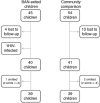The health of HIV-exposed children after early weaning
- PMID: 22099216
- PMCID: PMC3787136
- DOI: 10.1111/j.1740-8709.2011.00369.x
The health of HIV-exposed children after early weaning
Abstract
There are potential health risks associated with the use of early weaning to prevent mother-to-child transmission of human immunodeficiency virus (HIV) in resource-poor settings. Our objective was to examine growth and nutrient inadequacies among a cohort of children weaned early. Children participating in the Breastfeeding Antiretrovirals and Nutrition (BAN) Study in Lilongwe, Malawi, had HIV-infected mothers, were weaned at 6 months and fed LNS until 12 months. 40 HIV-negative, BAN-exited children were compared with 40 HIV-negative, community children matched on age, gender and local health clinic. Nutrient intake was calculated from 24-h dietary recalls collected from BAN-exited children. Anthropometric measurements were collected from BAN-exited and matched community children at 15-16 months, and 2 months later. Longitudinal random effects sex-stratified models were used to evaluate anthropometric differences between the two groups. BAN-exited children consumed adequate energy, protein and carbohydrates but inadequate amounts of fat. The prevalence of inadequate micronutrient intakes were: 46% for vitamin A; 20% for vitamin B6; 69% for folate; 13% for vitamin C; 19% for iron; 23% for zinc. Regarding growth, BAN-exited girls gained weight at a significantly lower rate {0.02 g kg(-1) per day [95% confidence interval (CI): 0.01, 0.03]} than their matched comparison [0.05 g kg(-1) per day (95% CI: 0.03, 0.07)]; BAN girls grew significantly slower [0.73 cm month(-1) (95% CI: 0.40,1.06)] than their matched comparison (1.55 cm month(-1) [95% CI: 0.98, 2.12]). Among this sample of BAN-exited children, early weaning was associated with dietary deficiencies and girls experienced reduced growth velocity. In resource-poor settings, HIV prevention programmes must ensure that breastfeeding stop only once a nutritionally adequate and safe diet without breast milk can be provided.
© 2011 Blackwell Publishing Ltd.
Conflict of interest statement
None of the above authors have any financial or personal interest in the above results and have no conflicts of interest to declare.
Figures
Comment in
-
The controversy of infant formula: does it have a role in managing child malnutrition in fully weaned infants?Matern Child Nutr. 2015 Oct;11(4):1050-2. doi: 10.1111/mcn.12067. Matern Child Nutr. 2015. PMID: 26417895 Free PMC article. No abstract available.
-
Response to the letter by Gedela.Matern Child Nutr. 2015 Oct;11(4):1053-5. doi: 10.1111/mcn.12066. Matern Child Nutr. 2015. PMID: 26417896 Free PMC article. No abstract available.
References
-
- Adu‐Afarwuah S., Lartey A., Brown K.H., Zlotkin S., Briend A. & Dewey K.G. (2007) Randomized comparison of 3 types of micronutrient supplements for home fortification of complementary foods in Ghana: effects on growth and motor development. American Journal of Clinical Nutrition 86, 412–420. - PubMed
-
- Bachrach V., Schwarz E. & Bachrach L.R. (2003) Breastfeeding and the risk of hospitalization for respiratory disease in infancy: a meta‐analysis. Archives of Pediatrics & Adolescent Medicine 157, 237–243. - PubMed
-
- Basu D. & de Jong R. (2006) Son Preference and Gender Inequality . Available at: http://www.econ.ohio-state.edu/dejong/gender2.pdf.
Publication types
MeSH terms
Substances
Grants and funding
LinkOut - more resources
Full Text Sources
Medical


